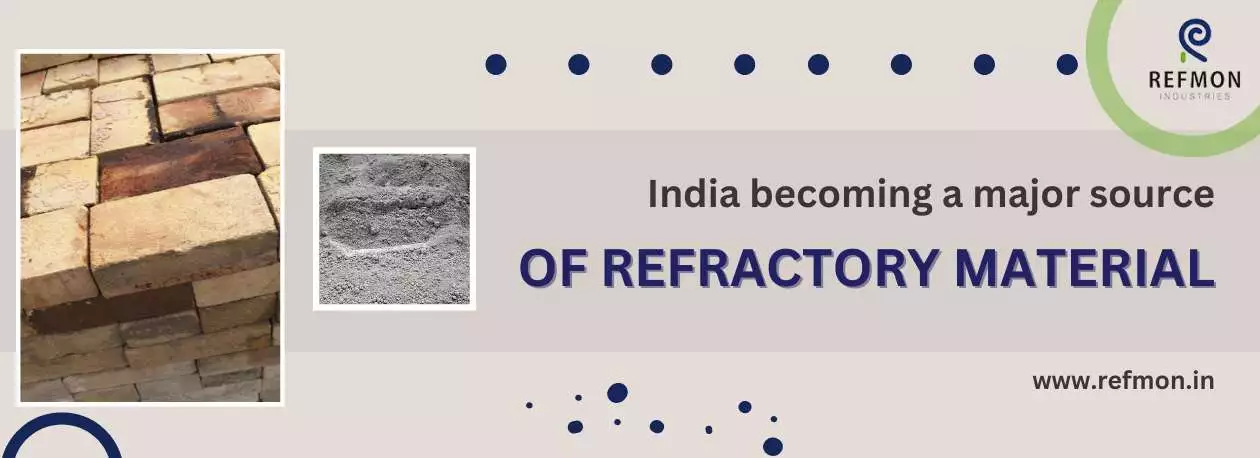
How is India becoming a major source of refractory material?
Substances that withstand high temperatures and maintain strength and integrity in harsh environments are refractory material. These materials are utilized in modern applications where outrageous intensity, erosion, and scraped spot can debase conventional materials or come up short. Ceramics, metals, or carbon-based materials are the most common refractory materials, which are made to withstand chemical and heat corrosion.
A wide range of natural and synthetic components, as well as combinations of minerals and compounds, are frequently used to make refractory bed material.
How refractory materials are used in steel production today
The furnaces lining material and other equipment used in steel production are lined with refractory materials. During the process of melting and refining steel, these materials can withstand the extreme temperatures, and chemical corrosion encountered.
- Manufacturing cement: Lining materials for cement manufacturing equipment and kilns are refractory. Both the resistance to chemical corrosion brought on by the reaction of raw materials and the high temperatures required to make cement is made possible by these materials.
- Glassmaking: Lining materials for glass making equipment and furnaces are refractory materials. These materials mitigate both the chemical corrosion brought on by the glass's reaction with the furnace materials and the high temperatures required to melt and shape the glass.
- Processing by petrochemicals: Petrochemicals like oil and gas are produced using refractory materials. These materials are strong enough to withstand the process's high temperatures and chemical corrosion because they are used to line reactors and other equipment.
- Incineration: In incineration plants, refractory materials line the furnaces and other equipment to burn waste. Both the chemical corrosion brought on by the waste's interaction with the furnace materials and the high temperatures required to burn the waste is mitigated by these materials.
India's growth as a source of refractory materials
There are several reasons why India has emerged as a significant supplier of refractory materials:
Raw materials are readily available: Natural resources like bauxite, fireclay, magnesite, and graphite—all of which are necessary for the production of refractory materials—abound in abundance in India. As a result, numerous refractory manufacturing facilities have been established nationwide.
Talented workforce: The refractory manufacturing sector can exploit India's abundant supply of unskilled and skilled laborers. In terms of production costs, this has contributed to developing a competitive advantage for Indian refractory manufacturers.
Increased demand: Expanding industries like steel, cement, glass, and petrochemicals drive the global demand for refractory materials. India's large manufacturing capacity puts it in a good position to meet this growing demand.
Aid from the government: The Indian government has taken many steps to help the refractory industry grow, such as providing tax breaks and subsidies for manufacturing facilities and investing in R&D.
Export capacity: Indian refractory manufacturers have been selling their products worldwide due to their low prices and high quality.
India has emerged as a significant supplier of refractory materials. As a result of the convergence of these factors, the industry is anticipated to expand further in the coming years.
The price of refractory bricks usually start from Rs 9/ per piece.
Acid proof bricks are used to made flooring to prevent from acid attack.
Conclusion
India has arisen as a significant wellspring of hard-headed materials because of the accessibility of natural substances, gifted workforce, developing interest, government backing, and commodity potential. By offering competitively priced high-quality products, India's refractory industry has been able to meet the needs of various industries, including steel, cement, glass, and petrochemicals. It is anticipated that the industry will continue to expand and contribute to the nation's economic development in tandem with the rising demand for refractory materials. The Indian government's help for the business through charge motivators and appropriations has likewise assisted with advancing its development. In this manner, India is ready to remain a central part of the stubborn worldwide industry.
Refmon industries is one of the refractory brick Manufacturers in India.